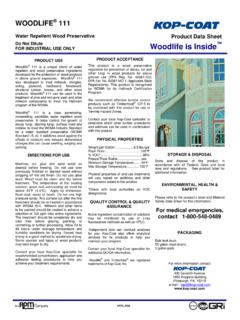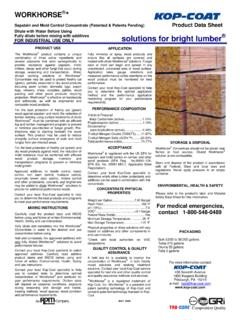Transcription of COATINGS FOR MILLWORK COMPONENTS - Kop …
1 Alan S. Ross, Vice President/Technical Director, Kop-Coat, Inc. The MILLWORK market has shown surprising resiliency in the past two years. However, the decline in the use of wood has led to a shrinking market for COATINGS . The term MILLWORK is often used quite broadly to define a wide variety of manufactured wood COMPONENTS used in construction including windows, doors, molding, skylights, etc. However, this article focuses on factory-applied COATINGS used over residential windows and doors. Historically, the vast majority of window frames were made entirely of wood. Metal window frames began to appear in the 1930 s, and vinyl windows have captured a growing share of the residential MILLWORK market since their introduction in the 1980 s. COATINGS are used over some metal COMPONENTS , but their main application is on wood windows and doors. The main types of COATINGS used in this market are water repellent preservative pretreatments, primers and topcoats.
2 Overall, the MILLWORK market is tied very closely to residential construction both new housing and replacement/remodeling. These segments have shown surprising resiliency over the past two years in what has been an otherwise lackluster economy. This performance, of course, is directly attributable to historically low interest rates that continue to drive growth in these market segments. For single family homes, the million units that were begun in 2002 represented the strongest performance since 1978. The National Association of Home Builders was optimistic that 2003 would be another good year, although down slightly from 2002. According to the WDMA (Window & Door Manufacturers Association), the volume of windows produced for single and multi-family housing in 2002 was 56 million units, an increase of over 1996 production. Precise figures are hard to come by because the majority of window manufacturers are privately held companies that do not release public sales figures.
3 However, it is clear that Americans have more windows in their homes than ever before. Fifteen years ago the average American home had 12 windows; now as homes get bigger and windows more popular, the average home has 16 windows. The trend is clearly toward more and bigger windows. Fifteen years ago the average American home had 12 windows. Now as homes get bigger and windows more popular the average home has 16 windows. May, 2004 1Of the 56 million window units produced, wood units comprised about 41%, vinyl 45% and aluminum 13% of the total. Vinyl windows continue to take share from both aluminum and wood, particularly in lower end windows. However, the growth of vinyl appears to be leveling off and is projected to stabilize around 2004-2005. Not all wood window COMPONENTS are primed or painted. In fact, the majority of wood window frames are clad with vinyl or aluminum extrusions rather than factory finished with COATINGS . Only about million of the million wood window units produced were comprised of non-clad wood.
4 Of these, about 80% ( million units) were coated with a factory applied primer and/or topcoat. Water-Repellent Wood Preservatives Industry standards require that all wood window COMPONENTS designed for exterior exposure, whether clad or non-clad, must be pre-treated with an EPA-registered water-repellent wood preservative. These protective COATINGS have been utilized to extend the service life of wood windows since the mid-1930 s. Until the 1980 s most of these treatments were based on pentachlorophenol (PCP) as the active ingredient. Modern treatments are based on preservatives such as IPBC, propiconazole and tebuconazole. These newer ingredients have excellent health, safety and environmental profiles and can provide protection for many years in service. Insecticides are often used in combination with the wood preservatives to provide protection against termites. The water repellents incorporated in these formulas add to performance by providing dimensional stability in situations where moisture intrusion can occur.
5 The carrier for these treatments is typically either an organic solvent such as mineral spirits, or water. As a carrier, water has the advantages of not having any flammability concerns and not being a contributor to air emissions. On the other hand, mineral spirits does not contribute to swelling or grain raising of wood and requires less energy to drive off than does water. In North America the main mode of application of water-repellent wood preservatives is by immersion treatment. Bundles of wood are typically dipped for three minutes while individual parts are immersed for about 25 seconds. This situation is quite different from that of most European countries where vacuum treatment is the norm. Once treated, the parts are dried, either in a forced hot air oven, or by evaporation under ambient conditions. After they are dry, COMPONENTS are then clad or coated before final assembly into finished windows. It is important that preservative treatments and primers/topcoats are designed for compatibility, since the water-repellent COMPONENTS of the preservative treatments can interfere with adhesion and wetting of some primers and topcoats.
6 Exact figures are unavailable, but the overall market for water-repellent wood preservative pre-treatments for MILLWORK is small relative to that of primers or topcoats. They are generally not used for doors. The market has been shrinking due to the growth of vinyl windows. Major suppliers include PPG and Kop-Coat. Primers Virtually all manufacturers of wood windows use primers in some facet of their production. Many windows are sold with a factory-applied primer that is intended to be topcoated by the building contractor or homeowner. Primers serve several purposes. In addition to providing a base surface to promote paint adhesion of the topcoat, primers also hide knots, sapstain blemishes and finger joints in window parts. Manufacturers utilize specific primer colors to distinguish their windows from competitors products. Primers are by far the largest category of COATINGS used for wood windows and doors. In North America the main mode of application of water-repellent wood preservatives is by immersion treatment.
7 This situation is quite different from that of most European countries where vacuum treatment is the norm. May, 2004 2 The majority of primers are waterborne emulsions based on either polyvinyl acetate, vinyl-acrylic or all-acrylic resin systems. Polyurea primers are used in high-performance paint systems. The most common application methods include spray and vacuum-assisted flow coater. Drying is generally accomplished through forced hot air ovens. Typical application rate is four mils on a wet basis. Several of the large paint companies produce MILLWORK primers. These include PPG, Akzo and Sherwin-Williams. However, the majority of window and door manufacturers purchase their primers from smaller, regional paint producers such as Grafted COATINGS , Pacific Chemtech, Iowa Paint, Davis-Frost and William Zinsser. Growth in the primer market has come mainly from their use on interior doors. As door manufacturers have moved away from solid wood toward laminates, plywood, OSB and hardboard, the use of primers has increased.
8 Again, the hiding power of primers is a major consideration in this application. Consequently, there has been a trend toward greater opacity in door primers. One area of growth is the use of tape wraps for window COMPONENTS as alternatives to liquid primers. Tape wraps are factory-applied films which serve the same purposes as primers but do not involve the use of liquid carriers. They have the same hiding and intercoat adhesion properties and can be finished at the factory or by the homeowner. Topcoats Due to the growing use of extruded claddings, relatively few wood windows today are factory finished with an exterior grade topcoat. Those topcoats that are used are generally very high performance COATINGS , since they have to compete with the weathering and fade-resistance characteristics of vinyl and aluminum extrusions. Typically, these COATINGS are applied by spray systems and dried in forced hot air ovens. COATINGS types include two- component urethane and two- component acrylic systems.
9 Suppliers include PPG and Grafted COATINGS . Important properties regarding high-performance topcoats include VOC content, color retention during long-term exposure, and cost. It is not uncommon for these COATINGS to carry 10-year performance warranties. As a consequence, their cost is quite high, typically in the range of $30-$40 per gallon. Market Trends Projections are that housing starts and window production will remain strong as long as interest rates remain low. The picture for MILLWORK COATINGS , however, is not as bullish. The use of water-repellent preservative pretreatments, while relatively small, will remain steady since these COATINGS are required for most wood COMPONENTS utilized in window production. The use of primers and topcoats, on the other hand, should continue to decline due to the growing use of vinyl and aluminum claddings. Profile of organization: Kop-Coat, Inc. combines the cumulative experience of two Fortune 500 companies, Koppers Co.
10 , Inc. and RPM, Inc. Kop-Coat s roots are in Koppers Company, which before its break-up in 1988 was the largest wood preservative company in the world. Since 1990, Kop-Coat has been a part of the RPM family of specialty COATINGS companies, one of America s largest COATINGS groups which includes Rust-Oleum, DAP, Carboline, Tremco and Stonhard. Kop- Coat is a global supplier of products for the protection of lumber, logs, MILLWORK , composite panels and engineered wood. May, 2004 3

